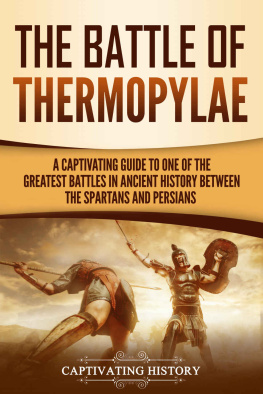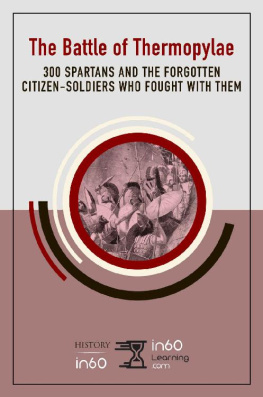THE BATTLE OF THERMOPYLAE
KEY INFORMATION
When: August 480 B.C.
Where: The coastal pass of Thermopylae, a Greek passage between northern and central Greece
Context: The Second Persian War (481-479 B.C.)
Belligerents: The Persian Empire against the allied Greek states led by Sparta
Commanders and leaders:
Leonidas I, King of Sparta (c. 540-480 B.C.)
Xerxes I, Great King of the Persian Empire (c. 519-465 B.C.)
Mardonius, Persian General (died in 479 B.C.)
Outcome: Persian victory
Victims:
Greek camp: the 300 Spartans of Leonidas I were killed, and probably the 700 Thespian allies (inhabitants of the Greek city in Boeotia), as well as an unknown number of Thebans
Persian camp: many deaths were suffered, but the exact number is unknown
INTRODUCTION
In 480 B.C., ten years after the first Persian War, the mighty Persian Empire prepared a second attempt to invade mainland Greece, while it already dominated the Greek cities of Minor Asia (now Turkey) and part of the Greek Islands, Thrace and Macedonia, north of Aegean Sea. During the summer, although a victory seemed impossible, the Greek cities put their rivalries aside and sought, on land and sea, to bar the way to the Persian army and its huge fleet. A contingent of several thousand men, led by Leonidas I, King of Sparta, was then sent to the narrow pass of Thermopylae, which led to the heart of Greece.
The Battle of Thermopylae belongs to the category of events that fueled European imagination for centuries, and went from history to legend. Almost everyone has heard of Leonidas I and his heroic Spartans, who stood up to the Persian Empire, at the dawn of the classical Greek era. Addressing this event therefore requires one to separate the story from the legend and, in particular, question the real political and military significance of Thermopylae: did this battle really aid the victory of the Greeks over the Persians, or has its importance been amplified over the centuries?
POLITICAL AND SOCIAL CONTEXT
AT THE HEART OF THE CONFLICT: THE MEDITERRANEAN EXPANSION OF THE PERSIAN EMPIRE
The great Persian offensive against Greece in 480 B.C. came as no surprise to the Greek cities which had time to prepare. Indeed, they had long suffered from the conquering ambitions of the powerful Eastern Empire.
The Greeks under Persian domination
The conflictual relations between Greece and the Persian Empire are rather ancient. Since the mid-6th century B.C., the Greek cities of Minor Asia were subject to Persian rule, which imposed the payments of tributes, sometimes garrisons, and intervened in their internal affairs. To control the various Greek cities, the Persian leaders would sometimes install tyrants acquired to their cause there, and would support them and maintain their power.
THE REVOLT OF IONIA
While the region enjoyed economic prosperity, the increased harshness of Darius I (King of Persia, c. 522-486 B.C.) provoked, between 499 and 493 B.C., the uprising of Ionia. Despite the support of Athens and Eretria which resulted in the ransacking of the city of Sardis in 498 B.C., the heart of Persian power in the region, the Greeks were finally defeated at Lade (west of Miletus). The repression was very severe and the city of Miletus was demolished. Darius I, who seemed to want to permanently resolve the Greek question, was preparing an offensive against the Greek mainland from 492 B.C. That year, the Great King managed to regain Thrace and Macedonia in Europe, regions that were conquered from 513 B.C.
THE FIRST PERSIAN WAR
Two years later came the first Persian War. The fleet of Darius I, which had nearly 600 ships, stormed Greece, under the orders of the Mede Datis (died after 490 B.C.). The Great King could count on rallying cities, as many Greek cities considered any resistance to be useless. However, Athens, which found itself virtually alone against the invader, managed to repel the Persians: the expected landing at Marathon, in Eastern Attica, was kept in check by the hoplites, particularly because the Persian cavalry had already re-embarked upon their arrival. This defeat did not affect the projects of the Persians, who showed themselves determined to continue their quest; preparations for a new expedition began a few years later.
Scene representing a battle between a Persian warrior and a Greek holpite painted on a Kylix, around 480 BC.
On the eve of the invasion of 480 B.C., the Greeks thus knew that Xerxes I, who succeeded his father Darius I in 486, was preparing a new attack.
THE PERSIAN EMPIRE, A SELF-ASSERTED POWER
The Persian Empire was a huge heterogeneous space, which extended from the Indus, near India, to the Mediterranean, and from the Caucasus to Arabia and Egypt. The empire thus included the countries of the Medes, located south of the Caspian Sea and the Greek historians named the offensives of Darius I and his son Xerxes in 490 and then in 480 B.C. after them. Conquered by Cyrus II (King of Persia, 556-530 B.C.) from 559 B.C., the empire was organized into satrapies (regions), each headed by a senior official, the satrap, appointed by the Great King. Therefore, there was a satrap in Sardis, on which the Greek cities of Ionia depended.
Despite various attempts at invasion, the Greek world remained a very secondary concern for them. The offensives of the early 5th century B.C. can thus be explained by the wish of Darius I to dominate the Aegean rather than Greece itself. Nothing indicates a systematic imperialist intention, nor a desire for a universal empire.
THE GREEK CITIES: A POLITICALLY DIVIDED SPACE
At the time of the Battle of Thermopylae, most of Greece was organized into cities, i.e. small independent states with permanent central institutions, and a highly fortified city, as well as developed artisanal and commercial activities.
In the early 5th century B.C., the Greek cities remained a highly divided group, where local and regional wars were practically permanent. Sparta, which had many allies gathered in the Peloponnesian League represented the main power, even though the city of Athens, which had just adopted a new democratic constitution, was on the rise. After the Battle of Marathon (490 B.C.), the discovery of silver-lead mines in the Laurion massif, in the heart of their territory, allowed the Athenians to build a large war fleet, the future instrument of their victories over the Persians and their dominance over Greece.
Besides these cities, a more archaic form of organization still existed, which the Greeks called ethnos (from the Greek meaning people or race), mainly in the western highlands and in the north. In this case, there was no capital city or permanent common institutions, but a network of more and less important villages. This was particularly the case in Thessaly, Macedonia and Phocis (in northern Greece).














